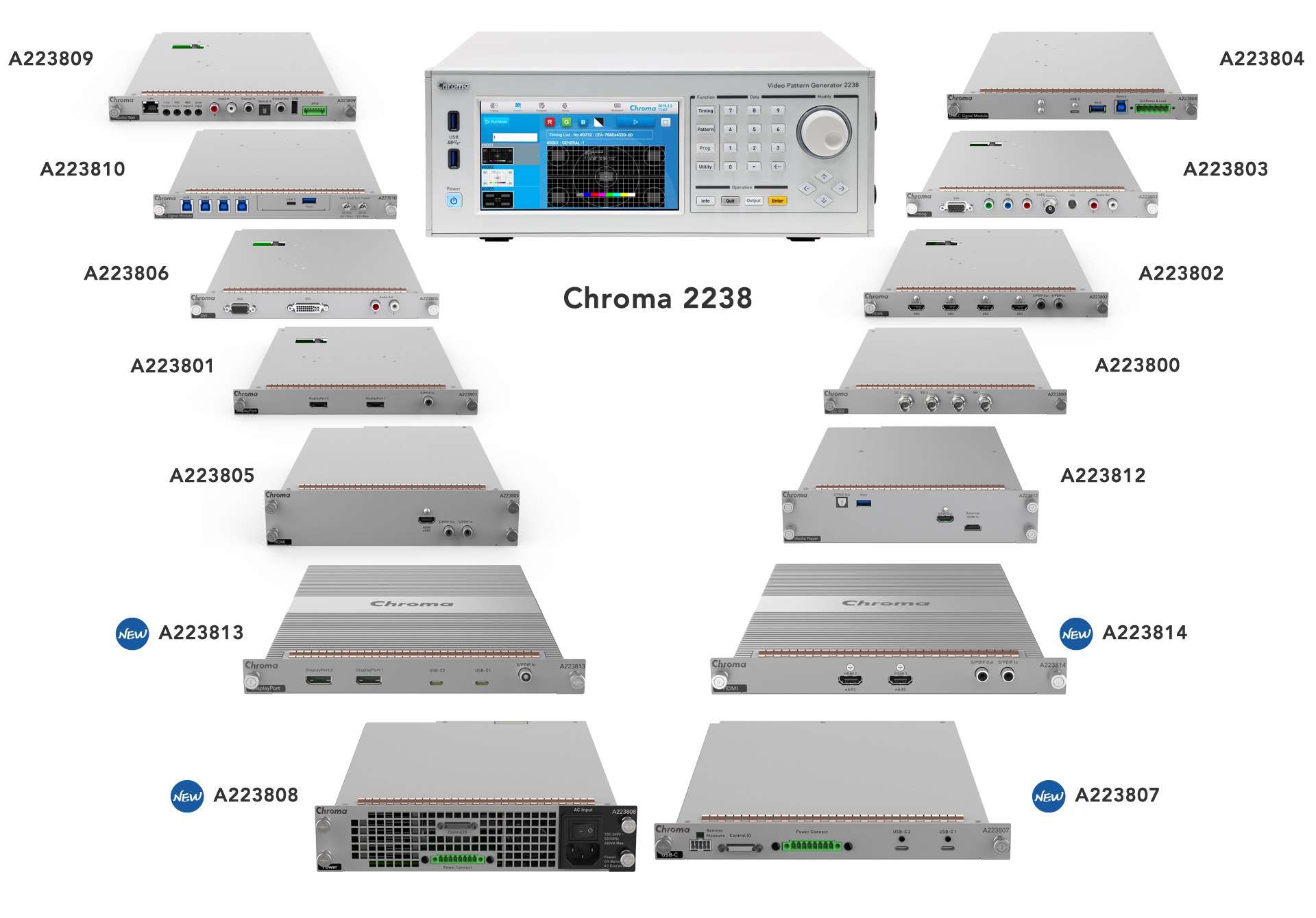
Tutte le seguenti specifiche sono preliminari e passibili di modifiche senza preavviso.
Chroma A223813 è dotato di unità di elaborazione grafica (GPU) ad alta velocità ed è completamente compatibile con lo standard audio/video VESA DisplayPort 2.1 UHBR (Ultra High Bit Rate). È in grado di raggiungere trasmissioni ad alta velocità fino a 20 Gbps tramite un metodo di codifica 128b/132b più efficiente. In confronto alle versioni precedenti di DisplayPort 1.4 HBR3 (High Bit Rate 3), Chroma A223813 è in grado di raggiungere una risoluzione massima di 16K, soddisfacendo i requisiti di performance dei display del futuro e supportando fino a 4 corsie di output. Oltre a consentire di impostare la velocità di corsia DP 2.1 UHBR20 (10/13,5/20 Gbps), Chroma A223813 supporta anche velocità di corsia DP 1.4 HBR3 inferiori (1,62/2,7/5,4/8,1 Gbps), coprendo tutti i requisiti per il test DisplayPort delle applicazioni odierne.
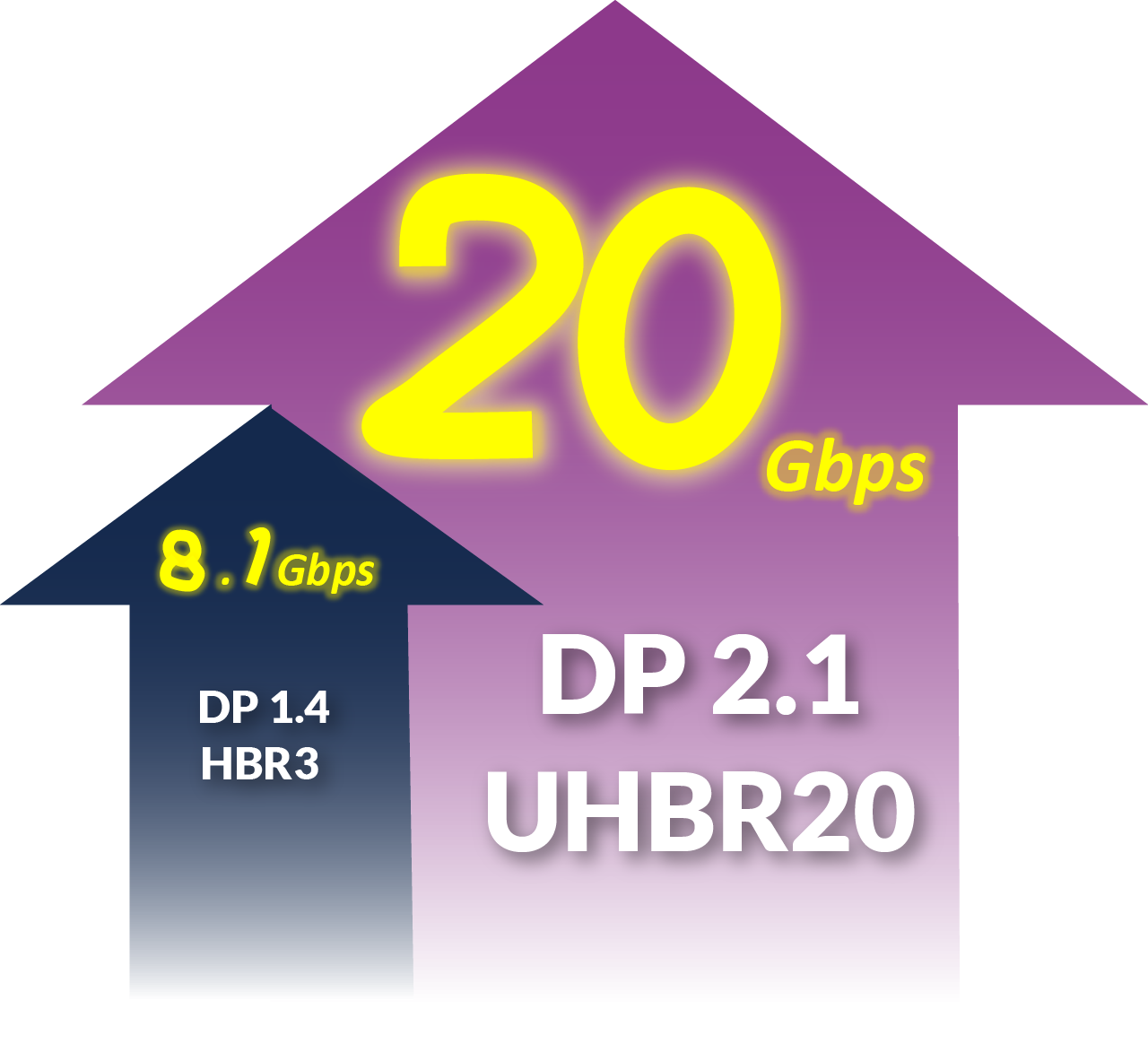
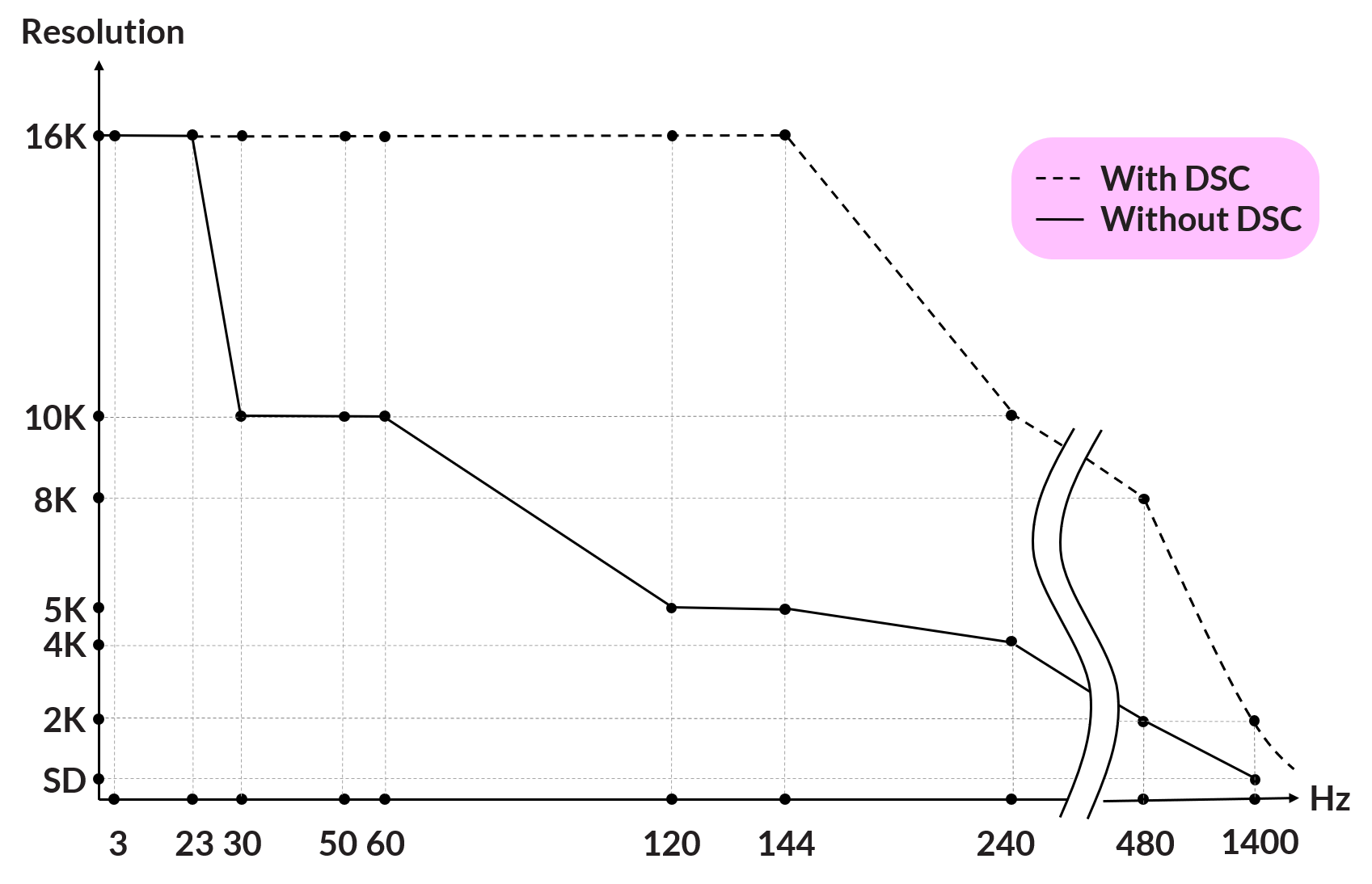
*L’applicazione effettiva dipende dal caso d’uso specifico.
Entrambe le interfacce di uscita DisplayPort e USB-C supportano DisplayPort 2.1 con una velocità di trasmissione fino a 20 Gbps per corsia. Con una banda totale di 80 Gbps su 4 corsie, in combinazione con la modalità DSC, il modulo è in grado di visualizzare immagini in definizione ultra-elevata 16K a 144 Hz. Questa soluzione soddisfa i futuri requisiti di test per immagini ad alta velocità in settori quali gaming, sanità e streaming.
*This feature is supported in firmware versions 3.03A and later.

Chroma A223813 supporta la commutazione tra 4 tipi di uscita DisplayPort e USB-C. Entrambe le porte DisplayPort e USB-C supportano un output fino a 20 Gbps. È possibile passare tra le diverse uscite dell’interfaccia senza scollegare fisicamente i cavi, riducendo i tempi del test e l’usura dei cavi, migliorando pertanto l'efficienza complessiva del test.

Chroma A223813 supporta DisplayPort indipendente e uscita USB-C in un'applicazione a 4+4 corsie. Ciò consente la suddivisione dell'immagine superiore/inferiore e sinistra/destra su un unico schermo. Inoltre, è possibile unire due output con una risoluzione massima di 16K a 288 Hz (con modalità DSC), consentendo una serie di applicazioni per test versatili.
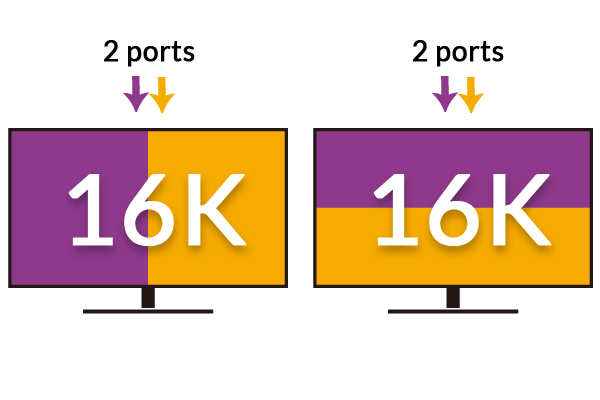
La funzione principale di Adaptive-Sync è quella di alleviare problemi come la latenza e la frammentazione delle immagini, soddisfacendo le esigenze delle immagini in rapido cambiamento durante l’esecuzione di giochi. I frame rate delle immagini dei videogiochi spesso fluttuano e Adaptive-Sync regola automaticamente la frequenza di aggiornamento dello schermo in base alle variazioni nei frame al secondo (FPS) dell’immagine trasmessa. In tal modo si riducono o eliminano problemi quali lag, tremolio e frammentazione delle immagini.

Chroma A223813 dispone di quattro modalità di test Adaptive-Sync: Saw, Ramp, Square e Arbitrary. È possibile regolare liberamente la frequenza di aggiornamento tra 20 Hz e 560 Hz per simulare varie frequenze di aggiornamento che il display potrebbe visualizzare durante il gioco. In modalità Arbitrary, è possibile personalizzare la frequenza di aggiornamento e i parametri di durata in base all’applicazione di test specifica.

▲ Saw

▲ Ramp

▲ Square

▲ Arbitrary

L’MST (Multi-Stream Transport) consente l'output delle immagini su più display in una configurazione a margherita. In tal modo si semplifica enormemente la configurazione dei cavi, dal momento che il segnale DisplayPort richiede solo una porta di uscita. Chroma A223813 supporta la trasmissione MST per un massimo di 4 flussi con una banda di fino 80 Gbps.

In modalità MST, Chroma A223813 supporta la commutazione tra quattro diversi dispositivi sotto test (DUT) collegati alla singola porta di uscita. Quando si testano più DUT in modalità MST, il modulo di test è in grado di emettere in simultanea diverse configurazioni di temporizzazioni e pattern attraverso quattro flussi indipendenti, consentendo il test di diverse uscite dell’interfaccia.
*This feature is supported in firmware versions 3.03A and later.

Chroma A223813 supporta VESA DSC (Display Stream Compression) versione 1.2a con un rapporto di compressione massimo di 3:1 (a 8bpp). Tramite la funzione DSC, è possibile trasmettere maggiori quantità di dati tramite la stessa larghezza di banda. Senza DSC, la specifica DP 2.1 supporta l'uscita fino a 16K a 23 Hz con codifica 4:4:4 a 8 bit. Quando DSC è abilitato, la frequenza di aggiornamento può essere aumentata a 16K a 144 Hz allo stesso livello di codifica e bit per colore.
*This feature is supported in firmware versions 3.01.11 and later.

The A223813 supports the DisplayPort 2.1 Panel Replay function. Based on information provided by the VSC (Video Stream Configuration) SDP (Secondary Data Packet), content can be transmitted to a designated update region of the screen. Users can configure up to five sets of X/Y coordinates with width and height ranges. The system then verifies whether the selected regions update as specified, enabling precise and efficient testing of the DUT’s Panel Replay function.
*This feature is supported in firmware versions 3.03A and later.

Chroma A223813 dispone di modelli per test di conformità integrati come OFF / D10.2 / PRBS7 / PLTPAT / CP2520 / TPS4 per facilitare l'esecuzione della verifica iniziale del CTS Link Training.

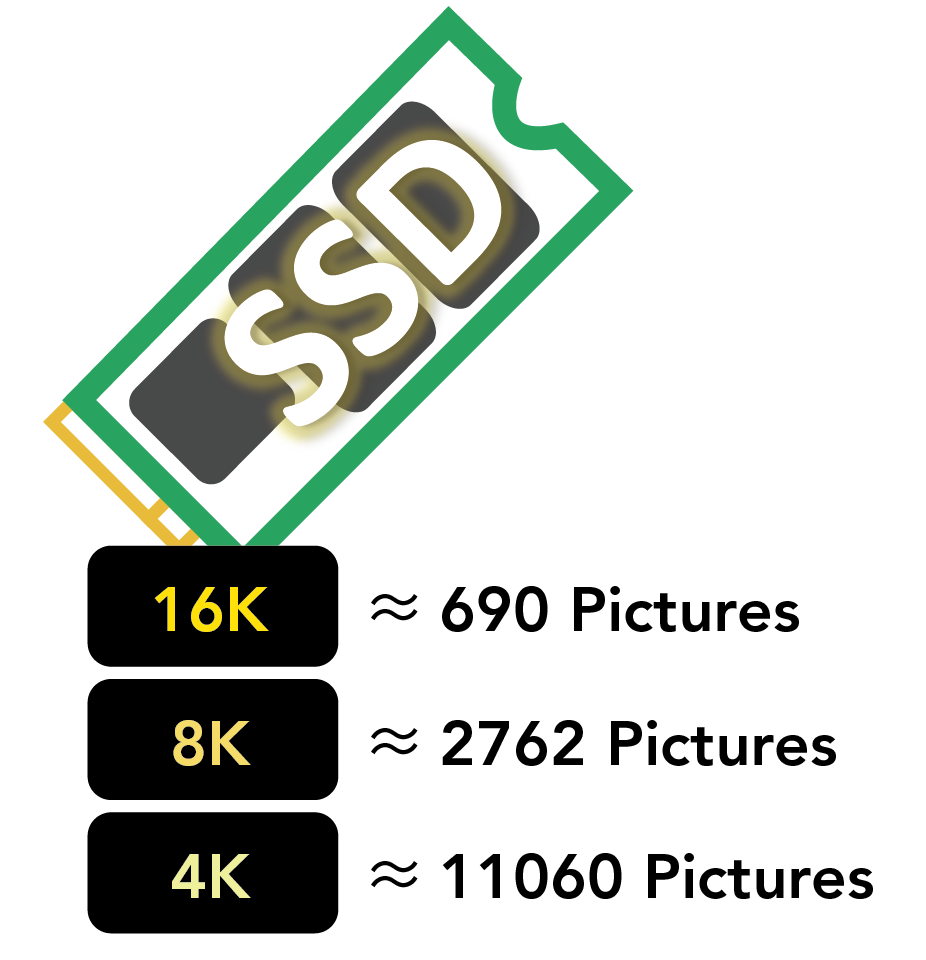
Chroma A223813 è dotato di un SSD integrato in grado di archiviare da 690 e 11.060 immagini circa in base alla risoluzione. Oltre all’uso di librerie immagini preinstallate, è possibile aggiungere le proprie immagini per test per sviluppare requisiti di test diversi.
Chroma A223813 è impostabile in modalità automatica, manuale o Training rapido. Supporta la configurazione di Conteggio corsie, Livello di oscillazione, Pre-enfasi, consentendo la simulazione di output di segnale non standard per condurre test relativi ai valori di picco del DUT.
- Lane Count:1 / 2 / 4 lanes
- Swing Level:400 / 600 / 800 / 1200 mV
- Pre-Emphasis:0 / 3.5 / 6 / 9.5 dB




Chroma A223813 supporta la trasmissione di immagini HDR (High Dynamic Range), tra cui voci di test per il funzionamento di HDR10+, HLG e HDR10. L’obiettivo principale qui è di valutare fattori che influenzano l’esperienza visiva del consumatore. Gli utenti dispongono della flessibilità per regolare i metadati HDR per condurre test sul funzionamento HDR pertinenti. È inclusa una vasta libreria di modelli per test HDR bidirezionali, con scala di grigi, barre di colore, modelli di finestre e altro ancora.
*HDR10+ functionality is supported in firmware version 3.01.11 and later.
Chroma A223813 supporta diverse uscite gamma di colore. Oltre agli spazi colore di base, supporta anche ampie gamme di colori come RGB, ITU-601, ITU-709, xvYCC-601, BT.2020-YC, BT.2020-RGB e DCI-P3 RGB. È possibile impostare formati di codifica pixel come YCbCr 4:4:4, 4:2:2, 4:2:0 e selezionare profondità di colore di 6, 8, 10, 12 o 16 bit per riprodurre una gamma di colori più ampia in modo da ottenere visualizzazioni di immagini naturali e ad alta risoluzione.
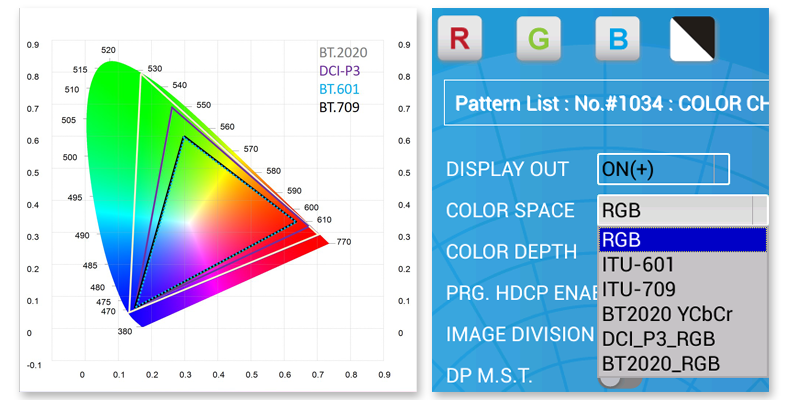

L’HDCP (High-Bandwidth Digital Content Protection) impedisce la copia illegale dei dati mentre vengono trasmessi attraverso l'interfaccia. A223813 supporta le versioni HDCP 1,3, 2.2 e 2.3 e consente di passare liberamente tra le tre versioni. Durante il test, i risultati possono essere trasmessi direttamente sullo schermo del DUT consentendo di visualizzare immediatamente le informazioni relative all’handshake HDCP.
Durante il test, Chroma A223813 è in grado di visualizzare in simultanea i risultati dei test pertinenti di due porte DisplayPort separate sullo schermo del DUT, supportato da due modalità: la modalità Pattern e la modalità Link Code. In modalità Pattern, viene eseguito automaticamente l’HDCP e i risultati sono visualizzati a schermo. In modalità Link Code, i passaggi della procedura HDCP sono eseguiti uno alla volta. Se la procedura di handshake non riesce, è possibile valutare intuitivamente i problemi e le potenziali cause.


Il DPCD (DisplayPort Configuration Data) funge da canale di comunicazione principale tra l'origine e il sink dell'interfaccia DisplayPort.
Chroma A223813 è dotato di rilevamento rapido del pattern in grado di leggere e interpretare il contenuto dei registri DPCD all'interno del dispositivo sorgente. Ciò include informazioni come le versioni DPCD supportate, le velocità massime di corsia, il numero massimo di corsie e le specifiche di supporto DSC. Queste informazioni sono visualizzate sullo schermo del DUT, consentendo di valutarne rapidamente le capacità e i risultati del link training.
The LTTPR (Link-Training Tunable PHY Repeater) function adjusts repeater devices during Link Training to ensure better channel quality. Through the DPCD channel, the A223813 automatically identifies the number of LTTPRs, their capabilities, and link configuration (Non-Transparent and Transparent modes). Link Training can then adjust Voltage Swing and Pre-Emphasis Levels to compensate for channel loss, improving signal integrity. The results are displayed directly on the screen.
*This feature is supported in firmware versions 3.03A and later.

La FEC (Forward Error Correction) è una tecnica impiegata nei sistemi di comunicazione unidirezionali per controllare gli errori di trasmissione. Implica l'invio di dati aggiuntivi insieme ai dati originali per consentire il ripristino degli errori e ridurre i tassi di errore di bit. Chroma A223813 supporta la FEC per la trasmissione di pacchetti, consentendo di evitare la perdita di dati o il danneggiamento durante la trasmissione. È in grado di correggere e riparare i dati automaticamente.

A223813 dispone di 8 generatori di segnali di test audio indipendenti integrati (FL/FR/RL/RR/FC/LFE/RLC/RRC), ciascuno dei quali presenta un interruttore di accensione/spegnimento di volume, tono, frequenza del tono, frequenza di campionamento, bit di campionamento e segnale di scansione, consentendo fino a 48 diverse combinazioni di test.


Il modulo presenta un FPGA (Field Programmable Gate Array) integrato che supporta un’unità di elaborazione grafica a 16K ultra-veloce, consentendo l’elaborazione rapida di una grande quantità di dati di immagini. In tal modo migliora significativamente la grafica e la velocità di trasferimento dati, con tempi di commutazione delle immagini rapidi fino a 200 ms a una risoluzione 16K, consentendo un recupero efficiente dei dati dall’SSD. Ciò migliora l'efficienza dei test e copre il test di prodotti a varie risoluzioni, consentendo infine di risparmiare sui costi di produzione.
L'esclusiva tecnologia di elaborazione ad alta frequenza utilizza linee a microstriscia per garantire l'adattamento dell'impedenza per la trasmissione del segnale e ridurre gli errori di inter/intra disallineamento per garantire la coerenza tra le varie porte di uscita.


Il software VPG Master incluso consente la compressione nel formato immagine DSC, supportando il caricamento di file immagini esterni per test (bmp, jpg, tiff) per archiviare fino a 100 immagini. È possibile personalizzare la risoluzione dell’immagine, la frequenza di aggiornamento, lo spazio colore, il taglio orizzontale o verticale e il rapporto di compressione. Inoltre è possibile contrassegnare le immagini con stringhe di testo fino a 31 caratteri con con font, dimensioni, colori e posizioni personalizzabili. Queste impostazioni personalizzate possono essere scaricate direttamente su Chroma 2238, consentendo di identificare semplicemente se la DSC (Display Stream Compression) è stata attivata o meno.
La funzione di programmazione integrata è utilizzabile per configurare le combinazioni di temporizzazione, pattern e audio necessarie per il DUT. È possibile memorizzare fino a 2000 sequenze e 5000 immagini e aggiungere i propri modelli di test per soddisfare un’ampia gamma di esigenze.


Il grafico del test della risoluzione integrato è in grado di indicare con precisione la scala corretta in base alle diverse tempistiche. Oltre alle forme geometriche e ai test delle proporzioni (4:3, 16:9), sono inclusi anche altri modelli di test compositi come la barra cromatica e la scala di grigi. Con questi modelli di test, è possibile determinare facilmente la qualità di immagine del display, funzione particolarmente utile a scopi di ricerca e sviluppo, produzione e controllo qualità.
Chroma A223813 è un modulo di segnale affidabile e imparziale che garantisce i migliori controlli di qualità dell'immagine e rigorosi test di integrità del segnale.


Il rame al berillio ad alta conduttività migliora la conduttività tra i componenti e riduce la dispersione di radiazioni elettromagnetiche che interferiscono con il DUT, in conformità con gli standard CE/EMC (compatibilità elettromagnetica).
In licenza dall'Institute of Image Information and Television Engineers, è disponibile un'ampia gamma di modelli di test del gamut cromatico ad risoluzione ultra-elevata a 8K. (opzionale)



Applicazioni: monitor da gioco, monitor aziendali, proiettori domestici/per cinema, applicazioni VR/AR, apparecchiature mediche, settore aerospaziale, segnaletica, automobili e altre applicazioni di prodotti di imaging.

monitor da gioco

monitor aziendali

proiettori domestici/per cinema

applicazioni VR/AR

apparecchiature mediche

settore aerospaziale

segnaletica

automobili
| Model | A223801 | A223813 |
|---|---|---|
| DisplayPort | DisplayPort 1.4 | DisplayPort 2.1 |
| GPU | 1 | 2 |
| DP Port(s) | 2 | 2 |
| USB-C | - | 2 |
| Resolution | 8K | 16K |
| Link Data Rate | 1.62 / 2.7 / 5.4 / 8.1Gbps (HBR 3) | 1.62 / 2.7 / 5.4 / 8.1 Gbps (HBR 3) 10 / 13.5 / 20 Gbps (UHBR 20) |
| Lane Count | 1 / 2 / 4 / 4+4 Lane(s) | 1 / 2 / 4 / 4+4 Lane(s) |
| MST | 4 Stream max | 4 Stream max |
| HDCP | v2.2 / v1.3 | v2.3 / v2.2 / v1.3 |
| Color Depth | 6 / 8 / 10 / 12 bits | 6 / 8 / 10 / 12 / 16 bits |
| Color Space | RGB / ITU-601 / ITU-709 / xvYCC-601 / BT.2020-YC / BT.2020-RGB / DCI-P3 RGB | RGB / ITU-601 / ITU-709 / xvYCC-601 / BT.2020-YC / BT.2020-RGB / DCI-P3 RGB |
| DSC | VESA DSC 1.2a (Software) | VESA DSC 1.2a (Software) |
| HDR | HLG / HDR 10 | HLG / HDR 10 / HDR10+ |
| Swing Level | 400 / 600 / 800 / 1200 mV | 400 / 600 / 800 / 1200 mV |
| Pre-Emphasis | 0 / 3.5 / 6 / 9.5 dB | 0 / 3.5 / 6 / 9.5 dB |
| 3D Format | Frame Sequential / Dual Pipe 3D | Frame Sequential / Dual Pipe 3D / Stacked Frame / Pixel Interleaved / Side-by-side |
| Adaptive-Sync | - | Frame rate 20~560Hz programmable |
| Sync Mode | - | Saw / Ramp / Square / Arbitrary |
| Panel Replay | - | ● |
| LTTPR | - | ● |
| FEC | - | ● |
| DPCD | ● | ● |
